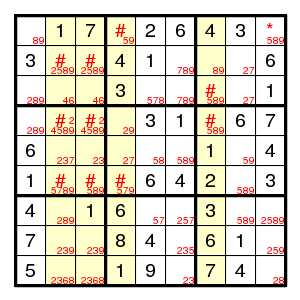Prev Up Next
Finned fish
In the page on matching we saw Principle C: a given digit defines
a matching between rows and columns, and if the matching is tight
for a subset, this may allow eliminations. The resulting argument was called
'X-wing' (on two lines), 'Swordfish' (on three lines), 'Jellyfish'
(on four lines). However, the argument can be made much more widely applicable.
Rule
A finned N-fish with elimination * for a given digit d
is a set of N rows together with a cell * not in one of these rows,
such that, after removal of all cells that 'see' * (i.e., lie in the
same row, column or box as *), the remaining cells in these N rows
that have d as a candidate lie in N-1 columns.
Since N digits d cannot lie in N-1 columns, it follows that the cell *
cannot be d, and we can eliminate this candidate.
(Or the same with rows and columns interchanged.)
If, not counting the row or column of *, all candidates for N rows
lie in N-1 columns, then all candidates for the remaining 9-N columns
lie in the remaining 8-N rows, also a contradiction. So one has
a finned N-fish iff there is a finned (9-N)-fish, and it is never
necessary to look at N larger than 4.
Example


After some work, the given puzzle has progressed to the second diagram.
The solution follows immediately from the finned 4-fish (jellyfish)
indicated. Look at the digits 5 in columns 2,3,4,7. They may occur
in rows 1,2,3,4,6. If (1,9)5, then the candidates in (1,4) and (3,7)
are impossible, and only rows 2,4,6 are left. But four digits 5
cannot be in three rows, so (1,9)!5. The complete solution now follows
quickly.
Prev Up Next



